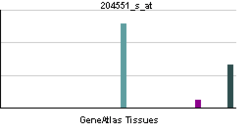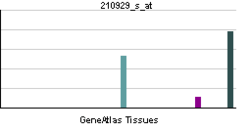alpha-2-HS-glycoprotein
| View/Edit Human | View/Edit Mouse |
alpha-2-HS-glycoprotein (AHSG) also known as fetuin-A is a protein that in humans is encoded by the AHSG gene.[3][4][5] Fetuin-A belongs to the fetuin class of plasma binding proteins and is more abundant in fetal than adult blood.
Function
Alpha2-HS glycoprotein, a glycoprotein present in the serum, is synthesized by hepatocytes. The AHSG molecule consists of two polypeptide chains, which are both cleaved from a proprotein encoded from a single mRNA. It is involved in several functions, such as endocytosis, brain development and the formation of bone tissue. The protein is commonly present in the cortical plate of the immature cerebral cortex and bone marrow hemopoietic matrix, and it has therefore been postulated that it participates in the development of the tissues. However, its exact significance is still obscure.[5]
The choroid plexus is an established extrahepatic expression site. The mature circulating AHSG molecule consists of two polypeptide chains, which are both cleaved from a proprotein encoded from a single mRNA. Multiple post-translational modifications have been reported.[6] Thus AHSG is a secreted partially phosphorylated glycoprotein with complex proeolytic processing that circulates in blood and extracellular fluids. In the test tube AHSG can bind multiple ligands and therefore has been claimed to be involved in several functions, such as endocytosis, brain development and the formation of bone tissue. Most of these functions await confirmation in vivo.
Fetuins like histidine-rich glycoprotein and kininogens are secreted (so-called type 3) cystatins.[7]
Fetuins are carrier proteins like albumin. Fetuin-A forms soluble complexes with calcium and phosphate and thus is a carrier of otherwise insoluble calcium phosphate.[8][9] Thus fetuin-A is a potent inhibitor of pathological calcification. Mice deficient in fetuin-A show systemic calcification of soft tissues.[10][11]
See also
References
- ↑ "Human PubMed Reference:".
- ↑ "Mouse PubMed Reference:".
- ↑ Rizzu P, Baldini A (1995). "Three members of the human cystatin gene superfamily, AHSG, HRG, and KNG, map within one megabase of genomic DNA at 3q27". Cytogenet. Cell Genet. 70 (1-2): 26–8. doi:10.1159/000133984. PMID 7736783.
- ↑ Osawa M, Umetsu K, Sato M, Ohki T, Yukawa N, Suzuki T, Takeichi S (September 1997). "Structure of the gene encoding human alpha 2-HS glycoprotein (AHSG)". Gene. 196 (1-2): 121–5. doi:10.1016/S0378-1119(97)00216-3. PMID 9322749.
- 1 2 "Entrez Gene: AHSG alpha-2-HS-glycoprotein".
- ↑ Jahnen-Dechent W, Trindl A, Godovac-Zimmermann J, Müller-Esterl W (November 1994). "Posttranslational processing of human alpha 2-HS glycoprotein (human fetuin). Evidence for the production of a phosphorylated single-chain form by hepatoma cells". Eur. J. Biochem. 226 (1): 59–69. doi:10.1111/j.1432-1033.1994.tb20026.x. PMID 7525288.
- ↑ Lee C, Bongcam-Rudloff E, Söllner C, Jahnen-Dechent W, Claesson-Welsh L (2009). "Type 3 cystatins; fetuins, kininogen and histidine-rich glycoprotein" (PDF). Frontiers in Bioscience. 14: 2911–2922. doi:10.2741/3422. PMID 19273244.
- ↑ Heiss A, Eckert T, Aretz A, Richtering W, van Dorp W, Schäfer C, Jahnen-Dechent W (May 2008). "Hierarchical role of fetuin-A and acidic serum proteins in the formation and stabilization of calcium phosphate particles". J. Biol. Chem. 283 (21): 14815–25. doi:10.1074/jbc.M709938200. PMID 18364352.
- ↑ Jahnen-Dechent W, Schäfer C, Ketteler M, McKee MD (April 2008). "Mineral chaperones: a role for fetuin-A and osteopontin in the inhibition and regression of pathologic calcification". J. Mol. Med. 86 (4): 379–89. doi:10.1007/s00109-007-0294-y. PMID 18080808.
- ↑ Westenfeld R, Schäfer C, Smeets R, Brandenburg VM, Floege J, Ketteler M, Jahnen-Dechent W (June 2007). "Fetuin-A (AHSG) prevents extraosseous calcification induced by uraemia and phosphate challenge in mice". Nephrol. Dial. Transplant. 22 (6): 1537–46. doi:10.1093/ndt/gfm094. PMID 17389622.
- ↑ Schafer C, Heiss A, Schwarz A, Westenfeld R, Ketteler M, Floege J, Muller-Esterl W, Schinke T, Jahnen-Dechent W (August 2003). "The serum protein alpha 2-Heremans-Schmid glycoprotein/fetuin-A is a systemically acting inhibitor of ectopic calcification". J. Clin. Invest. 112 (3): 357–66. doi:10.1172/JCI17202. PMC 166290
 . PMID 12897203.
. PMID 12897203.
Further reading
- Ketteler M, Vermeer C, Wanner C, et al. (2003). "Novel insights into uremic vascular calcification: role of matrix Gla protein and alpha-2-Heremans Schmid glycoprotein/fetuin.". Blood Purif. 20 (5): 473–6. doi:10.1159/000063554. PMID 12207096.
- Ketteler M (2005). "Fetuin-A and extraosseous calcification in uremia.". Curr. Opin. Nephrol. Hypertens. 14 (4): 337–42. doi:10.1097/01.mnh.0000172719.26606.6f. PMID 15931001.
- Yang F, Schwartz Z, Swain LD, et al. (1991). "Alpha 2-HS-glycoprotein: expression in chondrocytes and augmentation of alkaline phosphatase and phospholipase A2 activity.". Bone. 12 (1): 7–15. doi:10.1016/8756-3282(91)90048-N. PMID 2054237.
- Araki T, Yoshioka Y, Schmid K (1989). "The position of the disulfide bonds in human plasma alpha 2 HS-glycoprotein and the repeating double disulfide bonds in the domain structure.". Biochim. Biophys. Acta. 994 (3): 195–9. doi:10.1016/0167-4838(89)90293-8. PMID 2645941.
- Kellermann J, Haupt H, Auerswald EA, Müller-Ester W (1989). "The arrangement of disulfide loops in human alpha 2-HS glycoprotein. Similarity to the disulfide bridge structures of cystatins and kininogens.". J. Biol. Chem. 264 (24): 14121–8. PMID 2760061.
- Magnuson VL, McCombs JL, Lee CC, et al. (1988). "Human alpha 2-HS-glycoprotein localized to 3q27----q29 by in situ hybridization.". Cytogenet. Cell Genet. 47 (1-2): 72–4. doi:10.1159/000132509. PMID 3356172.
- Lee CC, Bowman BH, Yang FM (1987). "Human alpha 2-HS-glycoprotein: the A and B chains with a connecting sequence are encoded by a single mRNA transcript.". Proc. Natl. Acad. Sci. U.S.A. 84 (13): 4403–7. doi:10.1073/pnas.84.13.4403. PMC 305097
 . PMID 3474608.
. PMID 3474608. - Keeley FW, Sitarz EE (1985). "Identification and quantitation of alpha 2-HS-glycoprotein in the mineralized matrix of calcified plaques of atherosclerotic human aorta.". Atherosclerosis. 55 (1): 63–9. doi:10.1016/0021-9150(85)90166-2. PMID 3924066.
- Yoshioka Y, Gejyo F, Marti T, et al. (1986). "The complete amino acid sequence of the A-chain of human plasma alpha 2HS-glycoprotein.". J. Biol. Chem. 261 (4): 1665–76. PMID 3944104.
- Matsushima K, Cheng M, Migita S (1982). "Purification and physicochemical characterization of human alpha 2-HS-glycoprotein.". Biochim. Biophys. Acta. 701 (2): 200–5. doi:10.1016/0167-4838(82)90114-5. PMID 6803836.
- Gejyo F, Chang JL, Bürgi W, et al. (1983). "Characterization of the B-chain of human plasma alpha 2HS-glycoprotein. The complete amino acid sequence and primary structure of its heteroglycan.". J. Biol. Chem. 258 (8): 4966–71. PMID 6833285.
- Rizzu P, Baldini A (1995). "Three members of the human cystatin gene superfamily, AHSG, HRG, ((and KNG)), map within one megabase of genomic DNA at 3q27.". Cytogenet. Cell Genet. 70 (1-2): 26–8. doi:10.1159/000133984. PMID 7736783.
- Srinivas PR, Wagner AS, Reddy LV, et al. (1994). "Serum alpha 2-HS-glycoprotein is an inhibitor of the human insulin receptor at the tyrosine kinase level.". Mol. Endocrinol. 7 (11): 1445–55. doi:10.1210/me.7.11.1445. PMID 7906861.
- Nawratil P, Lenzen S, Kellermann J, et al. (1997). "Limited proteolysis of human alpha2-HS glycoprotein/fetuin. Evidence that a chymotryptic activity can release the connecting peptide.". J. Biol. Chem. 271 (49): 31735–41. doi:10.1074/jbc.271.49.31735. PMID 8940198.
- Osawa M, Umetsu K, Ohki T, et al. (1997). "Molecular evidence for human alpha 2-HS glycoprotein (AHSG) polymorphism.". Hum. Genet. 99 (1): 18–21. doi:10.1007/s004390050302. PMID 9003486.
- Osawa M, Umetsu K, Sato M, et al. (1997). "Structure of the gene encoding human alpha 2-HS glycoprotein (AHSG).". Gene. 196 (1-2): 121–5. doi:10.1016/S0378-1119(97)00216-3. PMID 9322749.
- Umekawa T, Iguchi M, Konya E, et al. (2000). "Localization and inhibitory activity of alpha(2)HS-glycoprotein in the kidney.". Urol. Res. 27 (5): 315–8. doi:10.1007/s002400050157. PMID 10550518.
- Olivier E, Soury E, Ruminy P, et al. (2001). "Fetuin-B, a second member of the fetuin family in mammals.". Biochem. J. 350 (2): 589–97. doi:10.1042/0264-6021:3500589. PMC 1221288
 . PMID 10947975.
. PMID 10947975. - Osawa M, Yuasa I, Kitano T, et al. (2001). "Haplotype analysis of the human alpha2-HS glycoprotein (fetuin) gene.". Ann. Hum. Genet. 65 (Pt 1): 27–34. doi:10.1046/j.1469-1809.2001.6510027.x. PMID 11415520.
- Haglund AC, Ek B, Ek P (2001). "Phosphorylation of human plasma alpha2-Heremans-Schmid glycoprotein (human fetuin) in vivo.". Biochem. J. 357 (Pt 2): 437–45. doi:10.1042/0264-6021:3570437. PMC 1221970
 . PMID 11439093.
. PMID 11439093.

